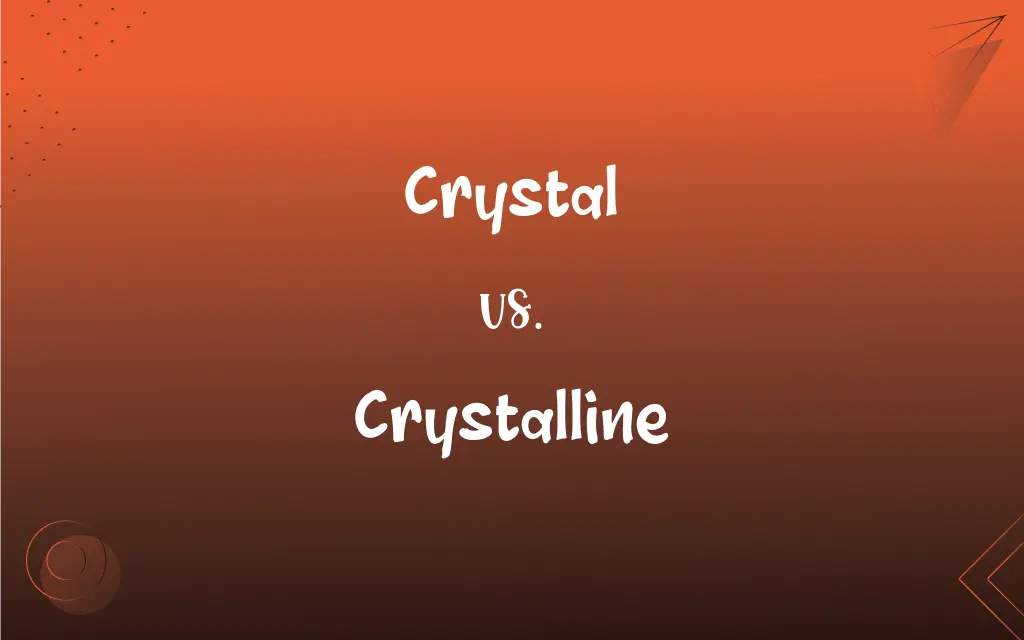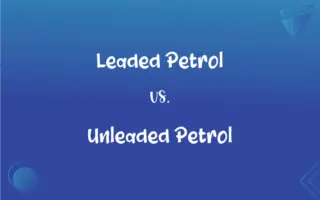Crystal vs. Crystalline: What's the Difference?
Edited by Harlon Moss || By Janet White || Published on December 30, 2023
Crystal is a solid material with a natural geometrically regular form and symmetrically arranged flat faces. Crystalline refers to describing a material that has a crystal-like structure.

Key Differences
A crystal is a solid where atoms are arranged in a highly ordered repeating pattern. On the other hand, crystalline refers to any material that exhibits some form of crystal-like atomic structure.
Crystals are often natural formations, like quartz or diamond. While, crystalline structures can be found in both natural and synthetic materials, indicating the presence of a crystal-like order.
The beauty of crystals lies in their well-defined geometric shapes. Whereas, crystalline materials may not always show such distinct geometric shapes but possess an underlying crystal-like order at the molecular or atomic level.
Crystals are used in jewelry and industrial applications for their physical properties. Meanwhile, crystalline structures are important in various fields, including materials science and pharmacology, for their unique characteristics.
The study of crystals, crystallography, reveals the arrangement of atoms in solids. The term crystalline is broader, encompassing any material that shares some properties of crystals, even if not fully crystal in nature.
ADVERTISEMENT
Comparison Chart
Definition
A solid with a naturally occurring, regular, and repeating structure
Describing a material that exhibits crystal-like properties
Form
Often natural, with clear geometric shapes
May not have visible geometric shapes but has an underlying order
Occurrence
Mostly natural formations
Found in both natural and synthetic materials
Applications
Jewelry, electronics, and industrial uses
Broad applications in materials science, pharmacology
Study
Crystallography focuses on the structure of crystals
Encompasses materials with various degrees of crystal-like order
ADVERTISEMENT
Crystal and Crystalline Definitions
Crystal
A substance in which the atoms are arranged in an orderly, repeating pattern.
Salt forms a crystal lattice that is visible under a microscope.
Crystalline
Appearing or being like crystal in clarity or transparency.
The crystalline waters of the lake were mesmerizing.
Crystal
A piece of a homogeneous solid substance with a natural geometrically regular form.
Diamond is a crystal known for its hardness and brilliance.
Crystalline
Relating to materials that are crystal-like in structure.
Silicon has a crystalline structure essential for semiconductor devices.
Crystal
A clear, transparent mineral, especially one that is highly valued.
Crystal vases are valued for their clarity and beauty.
Crystalline
Having a structure and form characteristic of crystals.
The crystalline structure of snowflakes is unique and complex.
Crystal
A naturally occurring solid with a definite geometric shape.
The quartz crystal is prized for its clarity and symmetry.
Crystalline
A term used in various scientific fields to describe a solid with some degree of crystal structure.
Certain polymers exhibit crystalline properties under specific conditions.
Crystal
Crystals are used in electronics for their ability to generate precise frequencies.
Quartz crystals are essential in making accurate watches.
Crystalline
Referring to the quality of being clear, transparent, and orderly structured.
The artist's crystalline sculptures captured light beautifully.
Crystal
A homogenous solid formed by a repeating, three-dimensional pattern of atoms, ions, or molecules and having fixed distances between constituent parts.
Crystalline
Being, relating to, or composed of crystal or crystals.
Crystal
The unit cell of such a pattern.
Crystalline
Resembling crystal, as in transparency or distinctness of structure or outline.
FAQs
What are examples of crystals?
Examples include quartz, diamond, and salt.
What is a crystal?
A crystal is a solid material with atoms arranged in a regular, repeating pattern.
What does crystalline mean?
Crystalline describes a material that has a crystal-like structure.
Can a material be crystalline without being a true crystal?
Yes, materials can be crystalline with partial crystal-like structures.
Are all crystalline structures visible to the naked eye?
No, many crystalline structures require microscopic examination.
What is crystallography?
Crystallography is the study of the arrangement of atoms in crystalline solids.
How are crystals formed?
Crystals form through processes like cooling, evaporation, or more complex biological methods.
What is the difference between amorphous and crystalline solids?
Amorphous solids lack the ordered structure of crystalline solids.
Can a crystal be formed from organic compounds?
Yes, many organic compounds can form crystals.
In what fields are crystalline materials used?
Crystalline materials are used in electronics, pharmacology, and materials science.
Do crystals have to be transparent?
Not all crystals are transparent; some can be opaque or translucent.
Is ice a crystal?
Yes, ice is a crystal with a hexagonal lattice structure.
Are crystalline materials always hard?
Not necessarily; crystalline materials can vary in hardness.
Are all minerals crystalline?
Most minerals have a crystalline structure, but there are exceptions.
How do temperature and pressure affect crystal formation?
Temperature and pressure can significantly influence the size and quality of crystals.
How do crystals affect light?
Crystals can refract, reflect, or diffract light, depending on their structure.
Can synthetic materials be crystalline?
Yes, synthetic materials can have crystalline structures.
What role do crystals play in technology?
Crystals are crucial in electronics, optics, and other technological applications.
Can crystals be grown artificially?
Yes, crystals can be grown in laboratories under controlled conditions.
How does the crystalline structure impact material properties?
The crystalline structure can determine a material's optical, electrical, and mechanical properties.
About Author
Written by
Janet WhiteJanet White has been an esteemed writer and blogger for Difference Wiki. Holding a Master's degree in Science and Medical Journalism from the prestigious Boston University, she has consistently demonstrated her expertise and passion for her field. When she's not immersed in her work, Janet relishes her time exercising, delving into a good book, and cherishing moments with friends and family.
Edited by
Harlon MossHarlon is a seasoned quality moderator and accomplished content writer for Difference Wiki. An alumnus of the prestigious University of California, he earned his degree in Computer Science. Leveraging his academic background, Harlon brings a meticulous and informed perspective to his work, ensuring content accuracy and excellence.






































































